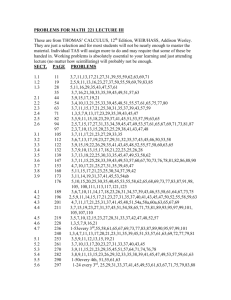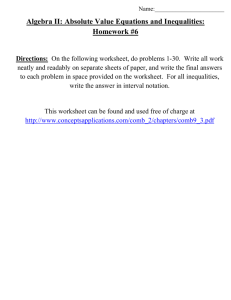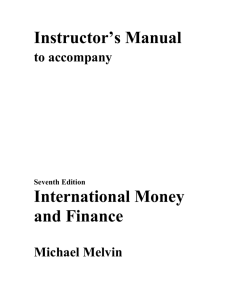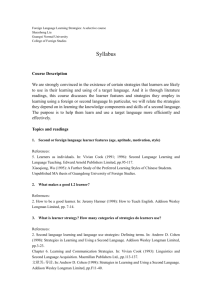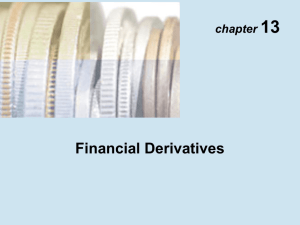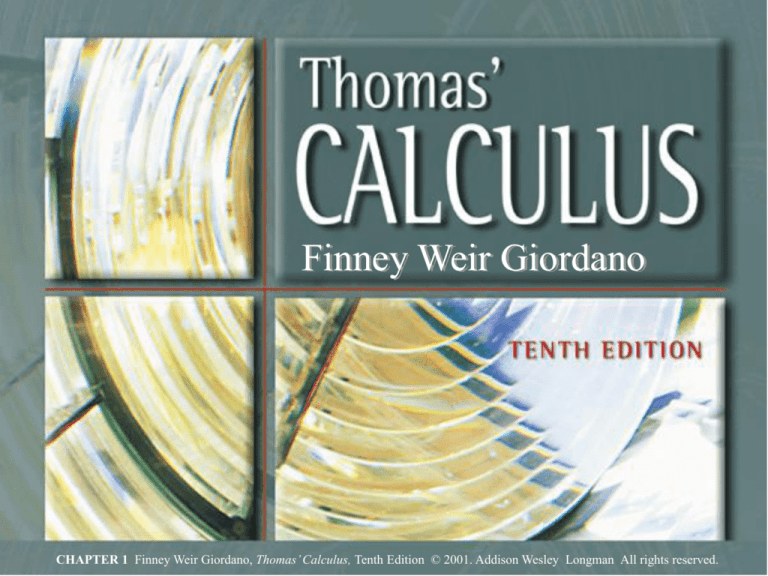
Finney Weir Giordano
1 Finney
Weir Giordano,
Thomas’
Tenth Wesley
EditionLongman
© 2001.AllAddison
Wesley
Chapter 1.CHAPTER
Finney Weir Giordano,
Thomas’
Calculus, Tenth
EditionCalculus,
© 2001. Addison
rights reserved.
Longman
All rights1,
reserved.
Chapter
Slide
1
Figure 1.3: The positions and slopes of four secants through
point P on the heat shield graph.
Chapter 1. Finney Weir Giordano, Thomas’ Calculus, Tenth Edition © 2001. Addison Wesley Longman All rights reserved.
Chapter 1, Slide 2
Figure 1.4: The tangent line at point P has the same steepness
(slope) that the curve has at P.
Chapter 1. Finney Weir Giordano, Thomas’ Calculus, Tenth Edition © 2001. Addison Wesley Longman All rights reserved.
Chapter 1, Slide 3
Figure 1.8: The functions in Example 7.
Chapter 1. Finney Weir Giordano, Thomas’ Calculus, Tenth Edition © 2001. Addison Wesley Longman All rights reserved.
Chapter 1, Slide 4
Figure 1.11: The relation of and in the definition of limit.
Chapter 1. Finney Weir Giordano, Thomas’ Calculus, Tenth Edition © 2001. Addison Wesley Longman All rights reserved.
Chapter 1, Slide 5
Figure 1.13: An open interval of radius 3 about x0 = 5 will lie
inside the open interval (2, 10).
Chapter 1. Finney Weir Giordano, Thomas’ Calculus, Tenth Edition © 2001. Addison Wesley Longman All rights reserved.
Chapter 1, Slide 6
Figure 1.14: The function and intervals in Example 10.
Chapter 1. Finney Weir Giordano, Thomas’ Calculus, Tenth Edition © 2001. Addison Wesley Longman All rights reserved.
Chapter 1, Slide 7
Figure 1.19: The Sandwich Theorem confirms that (a)
lim0 sin = 0 and (b) lim 0 (1 – cos) = 0.
Chapter 1. Finney Weir Giordano, Thomas’ Calculus, Tenth Edition © 2001. Addison Wesley Longman All rights reserved.
Chapter 1, Slide 8
Figure 1.23: The function y = sin (1/x) has neither a righthand nor a left-hand limit as x approaches zero. (Example 9)
Chapter 1. Finney Weir Giordano, Thomas’ Calculus, Tenth Edition © 2001. Addison Wesley Longman All rights reserved.
Chapter 1, Slide 9
Figure 1.24: The graph of f () = (sin )/.
Chapter 1. Finney Weir Giordano, Thomas’ Calculus, Tenth Edition © 2001. Addison Wesley Longman All rights reserved.
Chapter 1, Slide 10
Figure 1.25: The figure for the proof of Theorem 6.
TA/OA = tan , but OA = 1, so TA = tan .
Chapter 1. Finney Weir Giordano, Thomas’ Calculus, Tenth Edition © 2001. Addison Wesley Longman All rights reserved.
Chapter 1, Slide 11
Figure 1.27: The function in Example 3.
Chapter 1. Finney Weir Giordano, Thomas’ Calculus, Tenth Edition © 2001. Addison Wesley Longman All rights reserved.
Chapter 1, Slide 12
Figure 1.29: The function in Example 5(a).
Chapter 1. Finney Weir Giordano, Thomas’ Calculus, Tenth Edition © 2001. Addison Wesley Longman All rights reserved.
Chapter 1, Slide 13
Figure 1.37: The graph of y = e1/x for x < 0 shows
limx0– e1/x = 0. (Example 11)
Chapter 1. Finney Weir Giordano, Thomas’ Calculus, Tenth Edition © 2001. Addison Wesley Longman All rights reserved.
Chapter 1, Slide 14
Figure 1.42: The graph of f (x) = x + e–x looks like the graph
of g(x) = x to the right of the y-axis and like the graph of
h(x) = e–x to the left of the y-axis. (Example 14)
Chapter 1. Finney Weir Giordano, Thomas’ Calculus, Tenth Edition © 2001. Addison Wesley Longman All rights reserved.
Chapter 1, Slide 15
Figure 1.50: The function in (a) is continuous at x = 0; the
functions in (b) through ( f ) are not.
Chapter 1. Finney Weir Giordano, Thomas’ Calculus, Tenth Edition © 2001. Addison Wesley Longman All rights reserved.
Chapter 1, Slide 16
Figure 1.53: Composites of continuous functions are
continuous.
Chapter 1. Finney Weir Giordano, Thomas’ Calculus, Tenth Edition © 2001. Addison Wesley Longman All rights reserved.
Chapter 1, Slide 17
Figure 1.62: The tangent slope is
lim f (x0 + h) – f (x0)
h0
h
Chapter 1. Finney Weir Giordano, Thomas’ Calculus, Tenth Edition © 2001. Addison Wesley Longman All rights reserved.
Chapter 1, Slide 18

